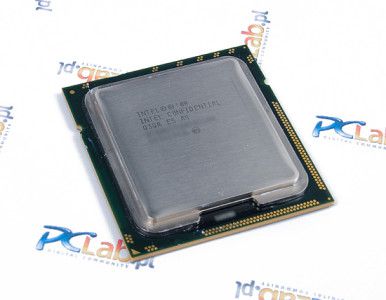From our front-page news:
Ahh, the leaks just keep coming! Yesterday, I posted about a leak that came out of Germany which involved Intel's entire upcoming Clarkdale line-up, seven models in all. Today's leak is a little more robust than a simple list of model names and expected information, though. Believe it or not, it's a full-blown review of Intel's upcoming Gulftown processor, the six-core beast built upon the company's Westmere micro-architecture.
Because Westmere is a derivative of Nehalem (resulting in it being part of Intel's "Tick" phase), performance from a six-core processor can be predicted in a lot of ways. Simple math will tell you that Gulftown should prove at least 50% faster in applications that can take advantage of the entire CPU, although in some cases, the improved architecture of Westmere might boost the performance just a wee bit more, while also improving power consumption and temperatures.
The 50% figure holds true throughout a lot of the synthetic benchmarks in PCLab's reviews. Most of SANDRA's results show a 48 - 50% improvement, while most of the real-world benchmarks don't show something so stark, as would be expected. Even Cinebench, a tool Intel itself uses to prove its processor's worth, can't take full advantage of the six-core CPU, showing just a 33% improvement over an equally-clocked Core i7 quad-core.
In tests such as video encoding, though, we are seeing rather nice gains. There's a 43% increase in performance where x264 is concerned, which is quite impressive. Likewise, there's a 46% gain in POV-Ray as well. As is mostly expected, the biggest gains are seen with true workstation apps, not the consumer apps. Still, it's nice to know that Gulftown is coming along, and I can't wait to take it for a spin myself in the months to come. But before that, it will be Westmere, the chip I have to admit I've been looking even more forward to.

The capacity ratio of the L3 cache to the number of cores remains the same: Bloomfield has 4 cores and 8 MB of L3, Gulftown has 6 cores and 12MB of L3. The L1D, L1C and L2 cache capacity remains unchanged. Also unchanged is the processor's “make-up” - in addition to six cores in a single block of silicon there is a block of L3 cache, a triple-channel memory controller and two QPI links. One of them is used to communicate with the IOH system and with the rest of the system (X58 desktop chipset or 5520 server chipset).
Source: PCLab
Because Westmere is a derivative of Nehalem (resulting in it being part of Intel's "Tick" phase), performance from a six-core processor can be predicted in a lot of ways. Simple math will tell you that Gulftown should prove at least 50% faster in applications that can take advantage of the entire CPU, although in some cases, the improved architecture of Westmere might boost the performance just a wee bit more, while also improving power consumption and temperatures.
The 50% figure holds true throughout a lot of the synthetic benchmarks in PCLab's reviews. Most of SANDRA's results show a 48 - 50% improvement, while most of the real-world benchmarks don't show something so stark, as would be expected. Even Cinebench, a tool Intel itself uses to prove its processor's worth, can't take full advantage of the six-core CPU, showing just a 33% improvement over an equally-clocked Core i7 quad-core.
In tests such as video encoding, though, we are seeing rather nice gains. There's a 43% increase in performance where x264 is concerned, which is quite impressive. Likewise, there's a 46% gain in POV-Ray as well. As is mostly expected, the biggest gains are seen with true workstation apps, not the consumer apps. Still, it's nice to know that Gulftown is coming along, and I can't wait to take it for a spin myself in the months to come. But before that, it will be Westmere, the chip I have to admit I've been looking even more forward to.

The capacity ratio of the L3 cache to the number of cores remains the same: Bloomfield has 4 cores and 8 MB of L3, Gulftown has 6 cores and 12MB of L3. The L1D, L1C and L2 cache capacity remains unchanged. Also unchanged is the processor's “make-up” - in addition to six cores in a single block of silicon there is a block of L3 cache, a triple-channel memory controller and two QPI links. One of them is used to communicate with the IOH system and with the rest of the system (X58 desktop chipset or 5520 server chipset).
Source: PCLab
